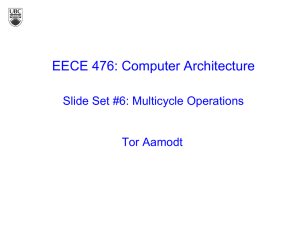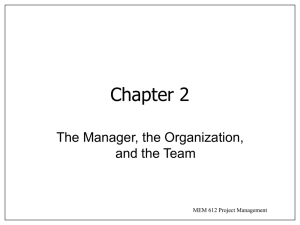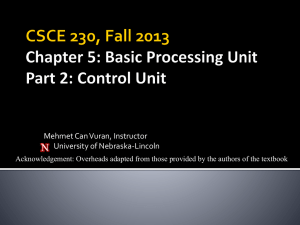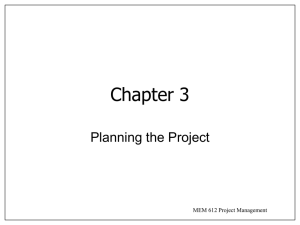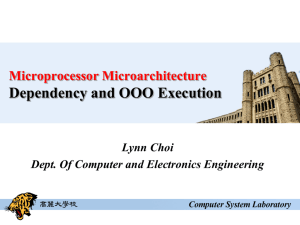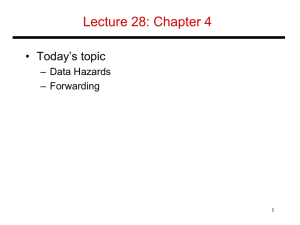Chapter 5 slides
advertisement
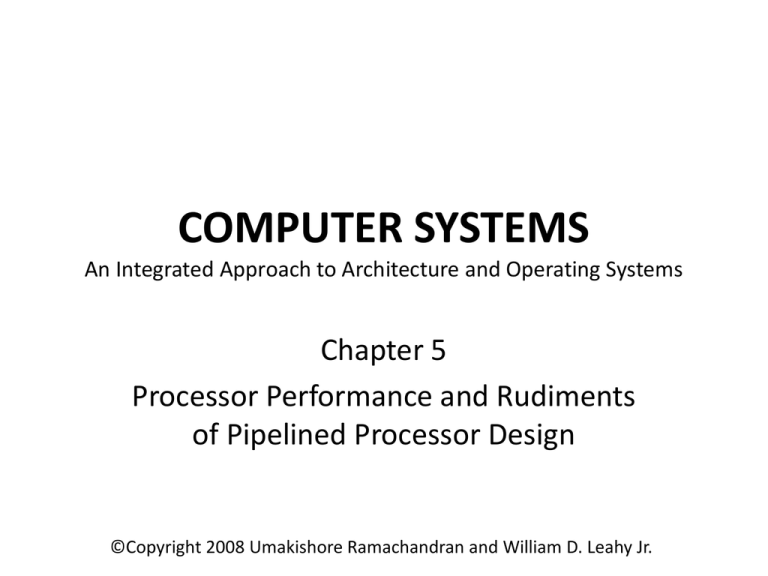
COMPUTER SYSTEMS An Integrated Approach to Architecture and Operating Systems Chapter 5 Processor Performance and Rudiments of Pipelined Processor Design ©Copyright 2008 Umakishore Ramachandran and William D. Leahy Jr. 5.1 Space and Time Metrics • Two important metrics for any program – Space: How much memory does the program code and data require? (Memory footprint) – Time: What is the execution time for the program? • Different design methodologies – CISC – RISC • Memory footprint and execution time are not necessarily correlated What determines execution time? • Execution time = (∑ CPIj) * clock cycle time, where 1 ≤ j ≤ n • Execution time = n * CPIAvg * clock cycle time, where n is the number of instructions (executed not static instruction count) 5.2 Instruction Frequency • Static instruction frequency refers to number of times a particular instruction occurs in compiled code. – Impacts memory footprint – If a particular instruction appears a lot in a program, can try to optimize amount of space it occupies by clever instruction encoding techniques in the instruction format. • Dynamic instruction frequency refers to number of times a particular instruction is executed when program is run. – Impacts execution time of program – If dynamic frequency of an instruction is high then can try to make enhancements to datapath and control to ensure that CPI taken for its execution is minimized. 5.3 Benchmarks • Benchmarks are a set of programs that are representative of the workload for a processor. • The key difficulty is to be sure that the benchmark program selected really are representative. • A radical new design is hard to benchmark because there may not yet be a compiler or much code. Evaluating a Suite of Benchmark Programs • Total execution time: cumulative total of execution times of individual programs. • Arithmetic mean (AM): Simply an average of all individual program execution times. – It should be noted, however that this metric may bias the summary value towards a time-consuming benchmark program (e.g. execution times of programs: P1 = 100 secs; P2 = 1 secs; AM = 50.5 secs). • Weighted arithmetic mean (WAM) : weighted average of the execution times of all the individual programs taking into account the relative frequency of execution of the programs in the benchmark mix • Geometric mean (GM), pth root of the product of p values. This metric removes the bias present in arithmetic mean SPECint2006 12 programs for quantifying performance of processors on integer programs Intel Core 2 Duo E6850 (3 GHz) Program name 400.perlbench 401.bzip2 403.gcc 429.mcf 445.gobmk 456.hmmer 458.sjeng 462.libquantum 464.h264ref 471.omnetpp 473.astar 483.xalancbmk Description Applications in Perl Data compression C Compiler Optimization Game based on AI Gene sequencing Chess based on AI Quantum computing Video compression Discrete event simulation Path-finding algorithm XML processing Time in seconds 510 602 382 328 548 593 679 422 708 362 466 302 5.4 Increasing the Processor Performance • Execution time = n * CPIAvg * clock cycle time • Reduction in the number of executed instructions • Datapath organization leading to lower CPI • Increasing clock speed 5.5 Speedup • Assume a base case execution time of 10 sec. • Assume an improved case execution time of 5 sec. • Percent improvement = (base-new)/base • Percent improvement = (10-5)/5 = 100% • Speedup = base/new • Speedup = 10/5 = 2 • Speedup is preferred by advertising copy writers Amdahl’s Law • Amdahl’s law: Timeafter = Timeunaffected + Timeaffected/x where x is speedup 5.6 Increasing the Throughput of the Processor • Don’t focus on trying to speedup individual instructions • Instead focus on throughput i.e. number of instructions executed per unit time 5.7 Introduction to Pipelining • Consider a sandwich shop with a five step process – – – – – Take order Bread Cheese Meat Veggies • One employee can do the job • Now imagine 5 employees making sandwiches Order Bread Cheese Meat Veggies Pipeline Math • If it takes one person 5 minutes to make a sandwich • And we pipeline the process using 5 people each taking a minute • And we start making sandwiches constantly (i.e. ignore startup pipeline filling) • How long does it actually take to make a single sandwich (Real elapsed time) • What is the effective time to produce a sandwich? (i.e. a sandwich exits from the pipeline every how many minutes?) 5.8 Towards an instruction processing assembly line Macro State FETCH DECODE EXECUTE (ADD) EXECUTE (LW) Functional Units in Use_______________ IR ALU PC MEM IR IR ALU Reg-file IR ALU Reg-file MEM Sign extender instructions instructions I4 F D E I3 I2 F D E I4 I3 I2 F D E F D E F D E F D E I1 F D E I1 F D E time time 5.9 Problems with a simple-minded instruction pipeline • The different stages often need the same datapath resources (e.g. ALU, IR). – Structural Hazards • The amount of work done in the different stages is not the same. – TFetch <> TDecode <> Texecute 5.10 Fixing the problems with the instruction pipeline • • • • • IF ID/RR EX MEM WB Instruction Fetch Instruction Decode/Read Registers Execute Memory Write Back Instruction pipeline with buffers between stages IF Instruction in B U F F E R ID/RR B U F F E R EX B U F F E R MEM B U F F E R WB Instruction out 5.11 Datapath elements for the instruction pipeline ID/RR IF PC I-MEM ALU B U F F E R DPRF A B Decode logic EX B U F F E R ALU-1 ALU-2 MEM B U F F E R D-MEM WB B U F F E R data DPRF 5.12 Pipeline-conscious architecture and implementation • Need for a symmetric instruction format • Need to ensure equal amount of work in each stage IF ID/RR EX MEM WB M X ADD 1 P C Instr Mem ADD 0? DPRF A M X ALU D SE Pipeline Registers Data Mem M X 5.12.1 Anatomy of an instruction passage through the pipeline IF F B U F ID/RR D B U F EX E B U F MEM M B U F WB Pipeline Buffers Name FBUF Output of Stage IF DBUF ID/RR EBUF EX MBUF MEM Contents Primarily contains instruction read from memory Decoded IR and values read from register file Primarily contains result of ALU operation plus other parts of the instruction depending on the instruction specifics Same as EBUF if instruction is not LW or SW; If instruction is LW, then buffer contains the contents of memory location read 5.12.2 Design of the Pipeline Registers • Design the pipeline registers solely for the LDR instruction FBUF DBUF EBUF MBUF 5.12.3 Implementation of the stages • Design and implementation of a pipeline processor may be simpler than a non-pipelined processor. • Pipelined implementation modularizes design. • Layout and interpretation of the pipeline registers are analogous to well-defined interfaces between components of a large software system. • Since datapath actions of each stage happen in one clock cycle, the design of each stage is purely combinational. Each stage: – At the beginning of each clock cycle, interprets input pipeline register, – Carries out the datapath actions using the combinational logic for this stage – Writes the result of the datapath action into its output pipeline register. 5.13 Hazards Structural Control Data • Reduce throughput to < 1 instruction/cycle • Pipeline is synchronous • Pipeline is stalled when an instruction cannot proceed to next stage. • A stall introduces bubble into pipeline. • NOP instruction is manifestation of bubble. • Stage executing NOP instruction does nothing for one cycle. • Output buffer remains unchanged from previous cycle. • Stalls, bubbles, and NOPs used interchangeably in the textbook to mean the same thing. 5.13.1 Structural hazard • Caused by limitations in hardware that don’t allow concurrent execution of different instructions • Examples – – – – Bus Single ALU Single Memory for instructions and data Single IR • Remedy is to add additional elements to datapath to eliminate hazard 5.13.2 Data Hazard • Consider these three pairs of instructions. Could they be executed in any sequence and yield correct results? R1 ← R2 + R3 R4 ← R1 + R5 R4 ← R1 + R5 R1 ← R2 + R3 R1 ← R4 + R5 R1 ← R2 + R3 5.13.2.1 RAW Hazard M X ADD 1 P C Instr Mem ADD BEQ DPRF A M X ALU D SE Data Mem M X 5.13.2.1 RAW Hazard M X ADD 1 P C Instr Mem ADD BEQ DPRF A M X ALU D SE R1 ← R2+R3 Data Mem M X 5.13.2.1 RAW Hazard M X ADD 1 P C Instr Mem ADD BEQ DPRF A M X ALU D SE R4 ← R1+R5 R1 ← R2+R3 Data Mem M X 5.13.2.1 RAW Hazard M X ADD 1 P C Instr Mem ADD BEQ DPRF A M X ALU D SE R4 ← R1+R5 R1 ← R2+R3 Data Mem M X 5.13.2.1 RAW Hazard M X ADD 1 P C Instr Mem ADD BEQ DPRF A M X ALU D Data Mem SE R4 ← R1+R5 R1 ← R2+R3 M X 5.13.2.1 RAW Hazard M X ADD 1 P C Instr Mem ADD BEQ DPRF A M X ALU D Data Mem M X SE R4 ← R1+R5 R1 ← R2+R3 5.13.2.1 RAW Hazard M X ADD 1 P C Instr Mem ADD BEQ DPRF A M X ALU D Data Mem M X SE R4 ← R1+R5 5.13.2.2 Solving the RAW Data Hazard Problem: Data Forwarding M X ADD 1 P C Instr Mem =? ADD R1 DPRF A M X ALU D SE R1 R4 ← R1+R5 R1 ← R2+R3 Data Mem M X 5.13.2.2 Solving the RAW Data Hazard Problem: Data Forwarding • Forwarding components have to be installed to take care of all possible cases 5.13.2.3 Dealing with RAW Data Hazard introduced by Load instructions M X ADD 1 P C Instr Mem ADD BEQ DPRF A M X ALU D SE LW R1,3(R2) Data Mem M X 5.13.2.3 Dealing with RAW Data Hazard introduced by Load instructions M X ADD 1 P C Instr Mem ADD BEQ DPRF A M X ALU D SE R4 ← R1+R5 LW R1,3(R2) Data Mem M X 5.13.2.3 Dealing with RAW Data Hazard introduced by Load instructions M X ADD 1 P C ADD R=1 Instr Mem R1 DPRF BEQ A M X ALU D SE R=1 R4 ← R1+R5 LW R1,3(R2) Data Mem M X 5.13.2.3 Dealing with RAW Data Hazard introduced by Load instructions M X ADD 1 P C ADD R1 Instr Mem DPRF BEQ A M X ALU D Data Mem R1 SE R=1 R4 ← R1+R5 LW R1,3(R2) M X 5.13.2.3 Dealing with RAW Data Hazard introduced by Load instructions M X ADD 1 P C ADD R1 Instr Mem DPRF BEQ A M X ALU D Data Mem R1 SE R=1 R4 ← R1+R5 NOP LW R1,3(R2) M X 5.13.2.4 Other types of Data Hazards • WAR – Not a problem in our pipeline • R4 ← R1 + R5 • R1 ← R2 + R3 • WAW – Becomes an issue in complex pipelines with many stages Stop Here 5.13.3 Control Hazard • Typically associated with branch instructions • PC must contain address of next instruction before we know it!!! • Simple solution: Stall pipeline • But what is the impact? 5.13.3 Control Hazard M X ADD 1 P C Instr Mem ADD BEQ DPRF A M X ALU D SE BEQ R1, R2, X Data Mem M X 5.13.3 Control Hazard M X ADD 1 P C Instr Mem ADD BEQ DPRF A M X ALU D SE ??? BEQ R1, R2, X Data Mem M X 5.13.3 Control Hazard M X ADD 1 P C Instr Mem ADD BEQ DPRF A M X ALU D SE NOP BEQ R1, R2, X Data Mem M X 5.13.3 Control Hazard M X ADD 1 P C Instr Mem ADD BEQ DPRF A M X ALU D SE NOP NOP BEQ R1, R2, X Data Mem M X 5.13.3 Control Hazard M X ADD 1 P C Instr Mem BEQ DPRF ADD A M X ALU D SE NOP BEQ R1, R2, X Data Mem M X 5.13.3.1 Dealing with branches in the pipelined processor • Delayed Branch • Branch Prediction • Branch prediction with target buffer 5.13.3.2 Summary of dealing with branches in a pipelined processor Name Pros Cons Examples Stall Simple Performance loss IBM 360 Predict (not taken) Good performance Predict (taken) Good performance Need additional hardware to be able Most modern processors use this to flush pipeline technique. Some Requires more also employ elaborate hardware sophisticated since target not branch target available until EX buffers Delayed Branch Needs no hardware just compiler recognition that it exists Deep pipelines make it difficult to fill all the delay slots Older RISC architectures e.g. MIPS, PA-RISC, SPARC 5.13.4 Summary of Hazards • Structural • Data • Control 5.14 Dealing with interrupts in a pipelined processor • First Method 1. Stop sending new instructions into the pipeline 2. Wait until the instructions that are in partial execution complete their execution (i.e. drain the pipe). 3. Go to the interrupt state • Second Method – The other possibility is to flush the pipeline. 5.15 Advanced topics in processor design • Pipelined processor designs have their roots in high performance processors and vector processors of the 1960's and 1970's • Many of the concepts used are still relevant today 5.15.1 Multiple Issue Processors • Sequential Program Model – Perceived Program Order Execution – Actual instruction overlap • Instruction Level Parallelism (ILP) – Limited by hazards especially control hazards – Basic blocks 5.15.2 Deeper pipelines • Pipelines may have more than 20 stages • Basic blocks are often in the range of 3-7 instructions • Must develop techniques to exploit ILP to make it worthwhile • For example, can issue multiple instructions in one cycle – Assume hardware and/or compiler has selected a group of instruction that can be executed in parallel (no hazards) • Need additional functional units 5.15.2 Deeper pipelines Necessity for Deep Pipelining • • • • • • • Relative increase in storage access time Microcode ROM access Multiple functional units Dedicated floating point pipelines Out of order execution and reorder buffer Register renaming Hardware-based speculation Different Pipeline Depths 5.15.3 Revisiting program discontinuities in the presence of out-of-order processing • External Interrupts can be handled by stopping instruction issue and allowing pipeline to drain • Exceptions and traps were problematic in early pipelined processors – Instructions following instruction causing exception or trap may have already finished and changed processor state – Known as imprecise execution • Modern processors retire instructions in program order – Potential exceptions are buffered in re-order buffer and will manifest in strictly program order. 5.15.4 Managing shared resources • Managing shared resources such as register files becomes more challenging with multiple functional units • Solutions – Scoreboard keeps track of all resources needed by an instruction – Tomasulo algorithm equips functional units with registers which act as surrogates to the architecture-visible registers 5.15.5 Power Consumption • Speeding up processors can drive designers to try and pack more smaller components onto the chip. • This can allow the clock cycle time to decrease • Unfortunately higher operational frequencies will cause power consumption to increase • Higher power consumption can also lead to thermal problems with chip operating temperatures 5.15.5 Power Consumption 5.15.6 Multi-core Processor Design • One solution to achieving higher performance without increasing power consumption and temperature beyond acceptable limits is multicore processors • Essentially the chip has more than one processor. • Such a design is not as transparent to the programmer as instruction level parallelism and as such brings a whole new set of challenges and opportunities to effectively utilize these new chips. 5.15.7 Intel Core Microarchitecture: An example pipeline 5.16 Historical Perspective • Amdahl works out basic pipelining principles for dissertation at UW-Madison in 1952 • Amdahl is chief architect of IBM s/360 where pipelining is implemented originally in high end mainframe processors • Early minicomputers did not use pipelining • Killer micros did use pipelining to get needed performance advantages • Today most all processors except for very low end embedded processors use some form of pipelining Questions?


